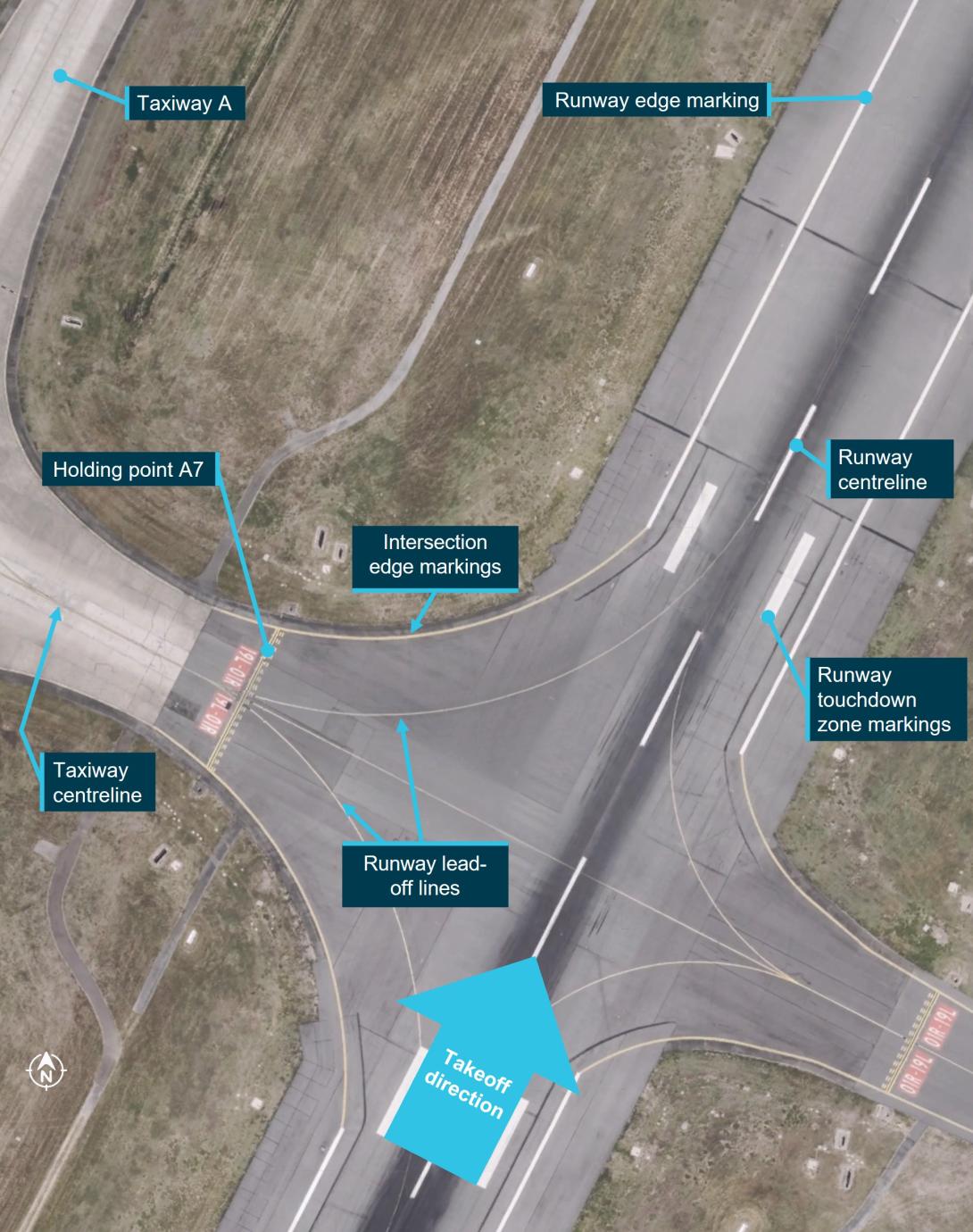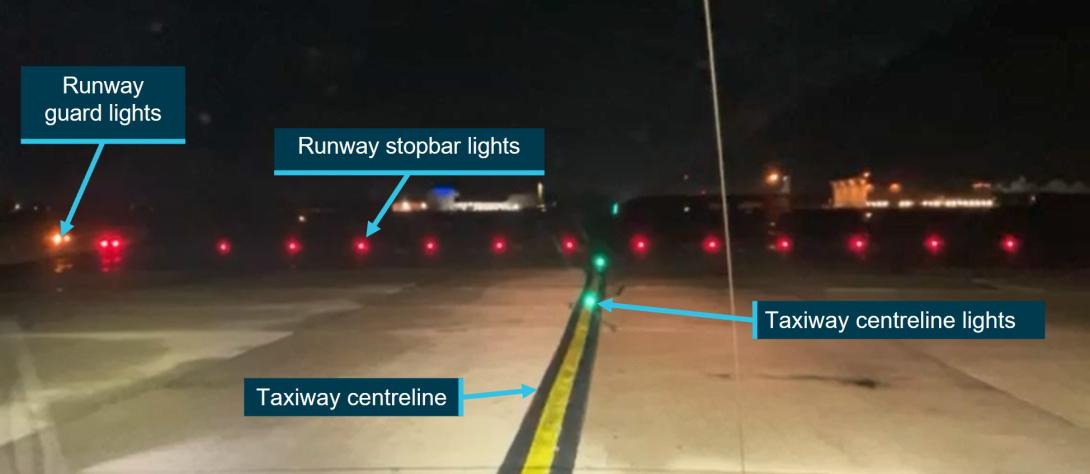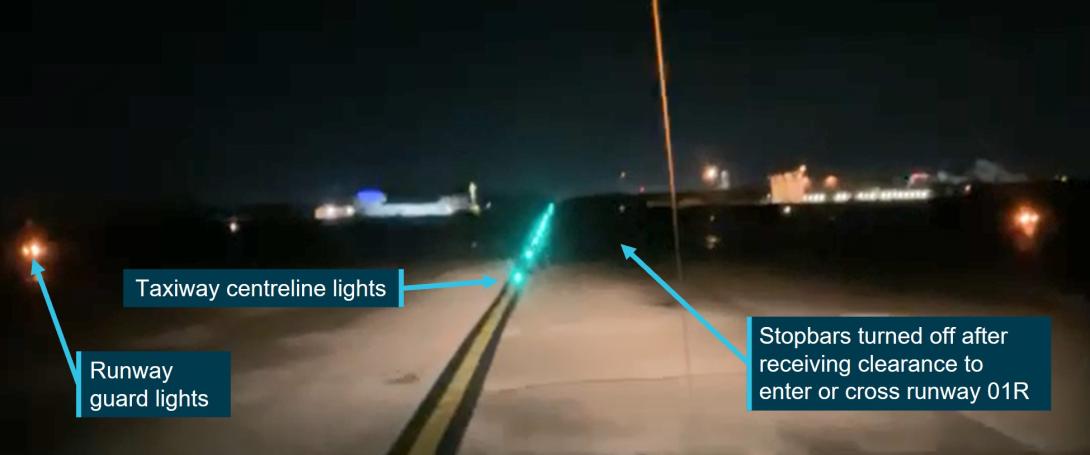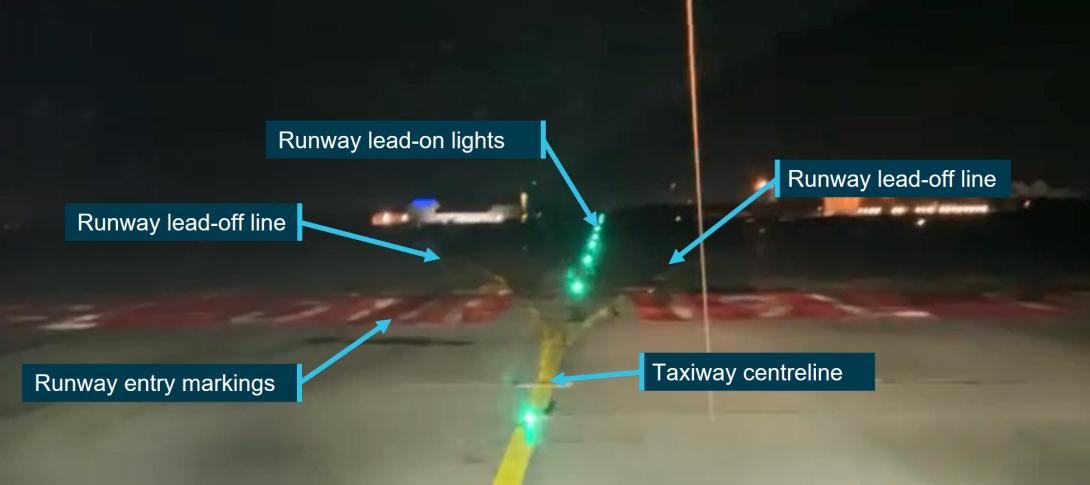| Occurrence Briefs are concise reports that detail the facts surrounding a transport safety occurrence, as received in the initial notification and any follow-up enquiries. They provide an opportunity to share safety messages in the absence of an investigation. Because occurrence briefs are not investigations under the Transport Safety Investigation Act 2003, the information in them is de-identified. |
What happened
At around 0537 local time (before sunrise) on 13 May 2024, an Aero Commander 500-S (AC500) was taxied for departure at Brisbane Airport, Queensland on a regular scheduled freight flight to Dalby Airport, Queensland. The pilot was the sole person on board.
The aircraft was cleared for a departure from runway 01R[1] at the intersection of taxiway A7, and the pilot taxied to this holding point. While turning onto the runway, the pilot inadvertently lined up along the left side runway edge lighting instead of the runway centreline.
During the take-off run, it became increasingly apparent to the pilot that the aircraft was to the left of the centreline, and they took corrective action to reposition the aircraft centrally on the runway and continued with the take-off. The aircraft rotated[2] and departed without further incident. The pilot later advised that they had mistaken the runway edge lights for centreline lighting and although after completing the turn onto runway 01R they noticed something ‘didn’t feel right’ with the position of the aircraft, they thought that the left wheel of the aircraft was to the right of the lights and so the aircraft was on the runway.
Around 10 minutes after take-off, the pilot contacted Brisbane ground controllers to report a possible ‘bump on the runway’ during the departure and advised of the need to conduct a runway inspection. An airport vehicle was sent to the intersection to investigate but no damage was identified at that time, and this information was relayed back to the pilot and the operator. A routine inspection of the runway was conducted at first light,[3] and this inspection also did not identify any damage at that intersection.
Four hours later at around 0934, another runway inspection was conducted for an unrelated matter. During this inspection multiple broken runway edge lights near the intersection with taxiway A7 were identified (Figure 1). The runway was briefly closed to traffic while standard procedures were followed to assess and clear the damage. CCTV footage was subsequently reviewed by the airport operator, and it was determined that the damage to the runway edge lights had been caused by the AC500 several hours earlier.
Figure 1: Damage to runway lighting at intersection of taxiway A7 and runway 01R

Source: Supplied, annotated by the ATSB
It was later established that the runway stop bars and all runway and taxiway lights were operational when the AC500 departed. Weather conditions were CAVOK[4] with no known limitations on ground visibility. A total of 3 runway edge lights were damaged. The operator reported some damage to the underside of the aircraft, but no injuries were reported.
Intersection lighting and markings
Markings
Taxiway
The taxiway had a single yellow unbroken centreline with a black border up to the runway holding point at A7, after which the line continued as an unbroken yellow line going straight across the runway. The holding point was marked with 2 solid lines and 2 broken lines. The taxiway edge was marked by a double yellow line, which intersected with the white runway edge line (Figure 2).
Runway
The runway centreline is a broken white line for the length of the runway. There were also 2 yellow taxiway lead-off lines (for the reciprocal runway) which led to holding point A7. The runway edge markings were solid white unbroken lines that run continuously for the length of the runway, except across intersecting taxiways.
Adding to the complexity of the layout at this intersection, is a pair of runway touchdown zone markings, which consist of thicker solid white lines that are between the runway edge lines and the runway centreline.
Figure 2: Overview of the markings at the intersection of taxiway A7 and runway 01R

Source: Google Earth, annotated by the ATSB
Lighting
Runway 01R had medium-intensity, omni-directional white runway edge lights and white centreline lighting. The A7 holding point had elevated flashing yellow runway guard lights, and a stop bar in the form of a row of red lights. The taxiway centreline lights were green. Videos were provided to the ATSB to illustrate the visual and lighting conditions at night at the intersection, and screenshots were taken from those videos to provide a visual representation. The taxiway lights and runway stop bar lights are shown in Figure 3.
Figure 3: Lighting on taxiway A7 approaching the stop bars prior to runway 01R

Source: Supplied, annotated by the ATSB
Once pilots are cleared to enter or cross runway 01R from holding point A7, the red stop bars were deactivated and the green lead-on lights activated as shown in Figure 4.
Figure 4: Lighting on taxiway A7 after clearance given to cross or enter runway 01R

Source: Supplied, annotated by the ATSB
Figure 5: Lighting and markings at intersection after clearance given to cross or enter

Source: Supplied, annotated by the ATSB
Figure 6 shows the likely position of the aircraft on the runway immediately prior to commencing the take-off run, and highlights the risk of not following the green taxiway lights onto the runway.
Figure 6: Likely line-up of AC500 on runway 01R immediately prior to take-off

Source: Supplied, annotated by the ATSB
Similarities to previous incidents
The misaligned take-off on 13 May 2024 was not the first such incident at that location. In October 2016, the ATSB investigated a near-identical occurrence involving a misaligned take-off and runway excursion from the same intersection at night.[5] On that occasion, pilot distraction at a critical moment prior to take-off contributed to them not noticing that the aircraft was incorrectly positioned on the runway. Another contributing factor was the darkness of the intersection and low visibility of the taxiway centreline markings. The pilot reported feeling that ‘something was not right’ and realigned the aircraft during the take-off run. The pilot did not believe they had hit any objects, but a subsequent inspection by ground personnel located several damaged left side runway edge lights. Since this incident, runway stop bars and lead-in lights have been introduced at Brisbane Airport as a visual aid to assist pilots.
Safety action
Following the incident, the operator issued a notice to their pilots in response to several incidents involving Aero Commander 500 aircraft at Brisbane Airport. This document noted that the AC500 ‘has the lowest taxiing pilot eye-height of any aircraft regularly using the airport’. This has resulted in pilots having difficulty with distance judgement and aircraft positioning on very wide taxiways and runways.
The document also advised pilots that the centreline of runway 01R, when viewed from taxiway A7, is raised to allow lateral water drainage. From the cockpit, the far side of the runway can be difficult to see, and pilots can mistake the runway centreline lights for the far side edge lights.
The operator also emphasised that AC500 pilots must follow the green ‘lead-on’ lights (see Figure 4) when lining up on the runway.
Safety message
This incident highlights the need for pilots to maintain situational awareness and avoid distractions when entering an active runway particularly at night. This is especially important in the seconds between receiving a clearance to enter the runway and completing the turn onto the runway. Radio calls, conflicting traffic, or the completion of standard checklist items such as the activation of landing and strobe lights can cause task-saturation and divert a pilot’s attention at a critical moment. In some circumstances, risk may also be reduced by limiting intersection departures to daylight hours only. This ensures that all aircraft departing between last light[6] and first light enter the active runway and commence their take-off run from the runway threshold where lighting and markings are most prominent.
The ATSB produced a research report, Factors influencing misaligned take-off occurrences at night, which outlines a series of conditions that are known to contribute to misaligned take-offs. Intersection departures were identified as one of 8 common factors which increased the risk of a misaligned take-off or runway excursion, with poor visibility and factors relating to lighting also contributing to past incidents.
About this report
Decisions regarding whether to conduct an investigation, and the scope of an investigation, are based on many factors, including the level of safety benefit likely to be obtained from an investigation. For this occurrence, no investigation has been conducted and the ATSB did not verify the accuracy of the information. A brief description has been written using information supplied in the notification and any follow-up information in order to produce a short summary report, and allow for greater industry awareness of potential safety issues and possible safety actions.
[1] Runway number: the number represents the magnetic heading of the runway. The runway identification may include L, R or C as required for left, right or centre.
[2] Rotation: the positive, nose-up, movement of an aircraft about the lateral (pitch) axis immediately before becoming airborne.
[3] First light: when the centre of the sun is at an angle of 6° below the horizon before sunrise. At this time the horizon is clearly defined but the brightest stars are still visible under clear atmospheric conditions.
[4] Ceiling and visibility okay (CAVOK): visibility, cloud and present weather are better than prescribed conditions. For an aerodrome weather report, those conditions are visibility 10 km or more, no significant cloud below 5,000 ft, no cumulonimbus cloud, and no other significant weather. [AIP GEN 3.5 – METEOROLOGICAL SERVICES, Section 4 METEOROLOGICAL REPORTS, paragraph 4.4.1, subparagraph g; and Section 12 AERODROME WEATHER AND FORECAST DECODE, paragraph 12.13 CAVOK.]
[5] Misaligned take-off involving Beechcraft B200, VH-XGV, Brisbane Airport, Queensland, on 26 October 2016 (AO-2016-142)
[6] Last light: the time when the centre of the sun is at an angle of 6° below the horizon following sunset. At this time, large objects are not definable but may be seen and the brightest stars are visible under clear atmospheric conditions. Last light can also be referred to as the end of evening civil twilight.


